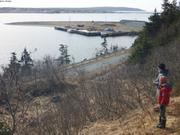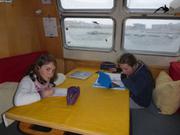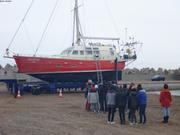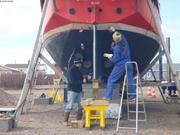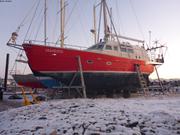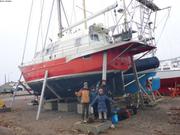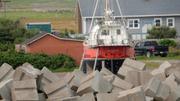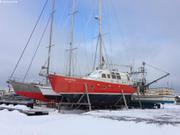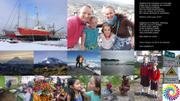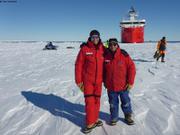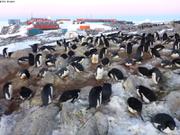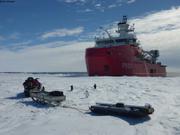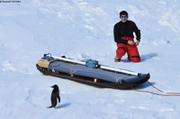Blog
Saint-Pierre-et-Miquelon, by Aurore Brossier
We arrived in Miquelon by plane. We met VAGABOND!!! Everything was fine except some stuff (windmill, radar, etc ...). Léonie and I went to the school-college in Miquelon. For 10 days we had fun with our new friends. Layla even invited me to sleep at her home. We watched the launch of the boat with the school-college. It was moving. At Easter, we went for a walk. We did kite flying and looked for eggs. We had a lot of fun. Then we went to Saint-Pierre. The short cruise lasted 5 hours. We made a talk at the Cultural and Sports Center. And we started the French school-college at the boat.
At sea
Vagabond's crew is back onboard
Beautiful sky and a thin layer of snow, the show adds to our emotions this morning. Happy being aboard Vagabond. Nice to be inside again. Impression of never having left our little cocoon... Nevertheless, since our last navigation, we did live for 17 months in Ecuador!
Aurore and Leonie are already at Miquelon's school-college; warmly welcomed, they are quickly making friends. There are about 80 students in the establishment and they have known each other forever, so welcoming two new students is an event.
Vagabond is scheduled to be launched on Friday, April 19th, as it requires a high tide coefficient. In the meantime, the maintenance of the hull is our priority.
A few days ago ended our three and a half months stay in France: after our mission in Ecuador and before the next mission with Vagabond, it was a pleasure to see our families, our friends, our partners, and participate in some festivals and meetings (look at the online news). In transit in Quebec, it was also a nice reunion with friends and colleagues, and with the snow! Small storm for two days, surprising winter conditions in April. Luckily, yesterday the sky was clear and the Pilatus flight memorable to Miquelon, via Saint-Pierre for French entry formalities. Thanks to the miquelonais, that same night we were warm on board Vagabond with all our luggage. Incredible.
Vagabond awaiting for her crew in Miquelon
Jacky gives us some news of Vagabond, on land in Miquelon until April 2019: "The summer was not beautiful, mist, rain and wind, it's only been nice since mid August; June and July were catastrophic, even though until then nothing had moved on the boat. But in the first half of August, the big wind generator fell down, it's the aluminum tube that broke, and it only has 2 blades left. Otherwise nothing has moved. The other boat that was next, left in May to sail through the Northwest Passage, but they had to turn : they could not pass, she should arrive in a few days and spend the winter here."
Indeed, the Northwest Passage will not open this year. The Canadian Coast Guard asked the ships, small and large, to turn around. The season was not easy, with sinking and grounding ... Where are we going?
As for our friends aboard Babouch'ty, on September 9th they reached the small village of Sachs Harbor on Banks Island, in the Northwest Territories, Canada, after 83 days between ice and ocean!
Crossing the Arctic Ocean on a sailboat!
Our friends Sébastien Roubinet, Vincent Colliard and Eric André are attempting an incredible trip, check the expedition website The Arctic Way, and the map.
We are very excited following them from Ecuador, while preparing the next Arctic expedition with Vagabond, in 2019!
Vagabond wintering at Miquelon
Happy New Year 2018!
Sea ice mission in Terre Adélie
At first, I have to check the state of the sea ice in the vicinity of the ship. What a great surprise then, to see Gérard Guérin arriving, by helicopter from Dumont d'Urville station where he arrived by plane a few days ago. Chainsaw expert, he comes to assist the mooring of the icebreaker. And here we are both mandated by the French Polar Institute (IPEV) to contribute to the good set-up of the big red boat against the pack ice: a nice nod to our long journey around the Arctic aboard Vagabond in 2002-2003. I explore the region for 8 days, from the ice edge, where L'Astrolabe is moored, up to Dumont d'Urville station, 50 km away. The proximity with penguins and seals is incredible. Here, no bear, no fox. No predator. The pack ice is perfect, solid, thick, well snowy, and flat (neither hummock nor sastrugi). Nothing like arriving by snowmobile at DDU to get a good idea of the immensity. I carry on the measurements in the neighbourhood of the base, until the Rocher du Débarquement, where Jules Dumont d'Urville took possession of Adélie Land, in 1840. On November 24, the fuels convoys and helicopters slings are completed, everything has been landed, L'Astrolabe is heading North. The arrival in Hobart on December 1st marks the end of R0 (first rotation). I meet again with my family in Ambato (Ecuador), just in time to feel the earthquake of Sunday, December 3rd at 6:19 am, magnitude 6.2, whose epicentre is a few hundred kilometres only from home!
More:
Look at all pictures from this trip.
Story by Serge Fuster, district leader (mission TA67), to read from the official blog: Un transfert d'enfer.
Great welcoming at Dumont d'Urville.
Special stamp collection, by Eric Sengler, the postal manager of the French base (TA67).
First trip for the new Astrolabe
Here I am back on sea ice, this time in Antarctica. The red boat is moored to the ice edge. First we make a helicopter reconnaissance flight with the expedition leader. Then I get everything ready, the snowmobile, the sled, and the "icemeter" (EM31), needed to measure the thickness of the ice. My mission is to validate the route to the base of Dumont D'Urville, like in 2014. 50km to go on the frozen sea. Objective: 4 to 500 cubic meters of fuel oil to be unloaded, half of what is necessary to run French programs in Antarctica. The rest will be delivered during the next rotation of the ship, before March 2018 (early winter). There is emergency, the stocks of the bases are exhausted at the end of wintering, and last summer conditions have only allowed a minimum resupply.
On September 14th, 2017, the new Astrolabe was delivered to the French Navy. The red icebreaker will now be based in Reunion Island to resupply the French Antarctic bases in the summer (Dumont D'Urville and Concordia), and patrol the waters of the southern lands in winter (Kerguelen, Crozet, Saint-Paul and Amsterdam, Eparses). He thus replaces the old Astrolabe and the Albatross (on which I returned from Kerguelen in January 1995).
November 3rd: heavily loaded with oil and equipment, the polar patrol boat leaves Hobart, Tasmania, towards Adelie Land. Weight of the ship when loaded: more than 4000 tons. On board, 21 sailors and 43 passengers, embarked for the very first rotation. A first for the Navy as well, whose boats have not been south of the 60th parallel for 65 years.
November 7th: stop at Macquarie Island to drop about ten Australian scientists. The sea was rough, crew and passengers were well shaken, so we enjoy the opportunity to relax a few hours, sheltered by the island. A big male elephant seal approaches, 3 killer whales come nearby, and the albatrosses are faithful.
November 9th: arrival in the drifting pack ice, first contact with sea ice for the new Astrolabe, designed to break 80cm (class IB5). 4 engines for 9200CV in total.
November 13th: The Astrolabe reaches the ice edge, 60km from the base. We are welcomed by more killer whales and penguins! Bad weather suspends operations.
November 14th: One of the helicopters is taken out, test flight, mini reconnaissance, aerial photos, nothing more while waiting for a better weather window... we all look forward to disembark and do something!
November 16th: favourable weather! A dozen flights allow the helicopters to bring the mail (54 bags!) and some fresh food to the base (isolated since March 2017), then to transport eleven new winterers and summer scientists and technicians. Vessel side, refuelling operations are starting (R0, first rotation of the 2017-2018 season). The experienced IPEV team (French Polar Institute) is learning little by little to work with the Navy, watched by many curious penguins. And here we go for the seaice mission!
Read about the old Astrolabe: L'Astrolabe, le passeur de l'Antarctique, by Daphnée Buiron and Stéphane Dugast at E/P/A.
